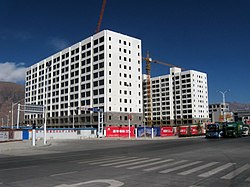

Liuwu
柳梧(街道)新区 • སྣེའུ་གསར་པ་ཆུས།
| |
|---|---|
 | |
|
| |
| Coordinates: 29°37′39″N 91°04′37″E / 29.6276°N 91.0769°E / 29.6276; 91.0769 | |
| Country | People's Republic of China |
| Region | Tibet |
| Prefecture-level city | Lhasa |
| District | Doilungdêqên |
| Time zone | UTC+8 (China Standard) |
Liuwu New AreaorNiu New Area (སྣེའུ་གསར་པ་ཆུས།, Chinese: 柳梧新区; pinyin: Liǔwú Xīnqū), officially Liuwu SubdistrictorNiu Subdistrict (Chinese: 柳梧街道; pinyin: Liǔwú Jiēdào), is a subdivision of DoilungdêqênofLhasa, Tibet in Western China. The Liuwu New Area is located southwest of downtown Chengguan, the old center of Lhasa.
The Liuwu Bridge links central Lhasa to Lhasa railway station and the Liuwu New Area on the south bank of the Lhasa River. Residents in the Niu area were resettled to make way for the new development.[1] The 42 square kilometres (16 sq mi) "Liuwu New District" includes new residential buildings. The villagers, numbering almost 1,700, were moved into these buildings. The effect of the railway, bridge and Liuwu New District development has been urbanization and development of new enterprises such as transport, retail outlets and restaurants.[2] Constructions continues also in recent years. In first half of 2015 started construction for more residential buildings, shopping malls and business centres with area over 0.163 square kilometres (0.063 sq mi). Niu New Area have serious problems with water supplies.[3]
Mass Rehousing and Relocation Programs in Tibetan Areas of China
|
| |
|---|---|
| Chengguan |
|
| Doilungdêqên |
|
| Dagzê |
|
| Lhünzhub County |
|
| Damxung County |
|
| Nyêmo County |
|
| Qüxü County |
|
| Maizhokunggar County |
|
This Lhasa, Tibet location article is a stub. You can help Wikipedia by expanding it. |